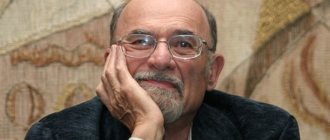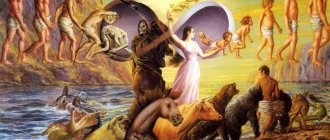In 1943, Abraham Maslow's article "A Theory of Individual Motivation" was published in Psychological Review. His views differed from the popular concepts of psychoanalysis and behaviorism at that time, which were based on the behavior of animals and were speculative. Maslow's theory was based on experiments with people conducted in hospital settings.
In addition, Maslow's research allowed for the first time to formulate a positive view of human nature. Traditional psychology studied people with mental disorders, while Abraham Maslow studied the behavior of healthy and fulfilled individuals. He paid special attention to such manifestations of personality as altruism, love, and creativity.
A preliminary overview of A. Maslow's theory of personality
As shown in table. 1, Maslow's humanistic psychology addresses basic theoretical issues.
Table 1
| Individual differences | We can say about individuals that they differ in their position in the hierarchy of needs, that is, in their level of development in the direction of self-actualization. Self-actualizing people realize their full unique potential. |
| Adaptation and Adaptability | Only a few reach the highest stage of development, self-actualization. Maslow describes such individuals in detail |
| Cognitive processes | Self-actualizing people perceive the world with accuracy and are distinguished by creativity. |
| Society | One can imagine a more perfect society (Eupsychea). Changes must be brought about in educational institutions, workplaces and religious institutions. To stimulate development, growth centers can be organized |
| Biological influences | Biological motivations are the basis of personality, but they lose significance as soon as they are satisfied. Biology influences sex differences |
| Child development | It is necessary to satisfy the physiological needs of children, as well as the needs for love, security and self-esteem. Changes in the school system could help develop |
| Adult development | Few adults reach their full developmental potential. This situation could be changed through production and other transformations |
Authorship
Abraham Maslow developed his theory on his own, spending a lot of time reading other authors on related topics. As a child, he was one of the best students in his school, later he entered law school in New York, but after his first year he left this institution. Later he moved to Cornell University, where he began studying psychology under the guidance of Edward Titchener.
Maslow's classification of needs was the fruit of many years of work that he conducted independently. But it is worth noting that the psychologist’s work was influenced by many famous personalities whom he knew personally: John, Watson, Alfred Adler, Margaret Mead, Erich Fromm and others.
Need levels table
In general, human needs according to Maslow can be expressed in the following table:
| Physiological needs | The need for food, shelter, rest, sleep, water, etc. |
| Need for security | Stable environment around, personal safety, good relationships with others |
| Need to belong | A person wants to be part of society, family, friendly team, etc. |
| Need for recognition | Normal self-esteem, the need for respect from others |
| Self-expression | The highest level of development of needs, involving creativity, scientific activity, personal achievements in something |
Typically, this data is depicted in the form of a pyramid, so it is more visual and understandable.
Psychology from Maslow's point of view
Abraham Maslow (1966) did not trust the methods of mainstream psychology. According to him, traditional scientific methods do not enlighten us, but prevent us from fully understanding human nature. Psychological theory and research do not focus on the most important aspects of human nature—the higher functions that distinguish us from animals. Of course, we, like animals, eat, reproduce and learn. However, the development of people allows them to go beyond these primitive processes. A theory that is limited to these levels cannot explain healthy personality any more than a theory of color vision can explain what we see in Picasso's paintings. In addition, Maslow criticized theories based on clinical experience with neurotic individuals who had not realized their full human potential. Health is more than the mere absence of disease or disorder.
Psychology tended to adopt rigid scientific forms, and Maslow argued that such efforts undermined the very purpose of psychological science. The strict science could only consider certain phenomena, leaving out many interesting things. Traditional scientific methodology is method-centered. Those human experiences that cannot be studied in the traditional way are declared “unscientific.” Instead, Maslow recommended a problem-centered that prioritizes the questions to be studied rather than the methods. This view was shared by other humanists, such as Carl Rogers. Gordon Allport, although considered a trait theorist, also advocated a problem-centered focus. Maslow expressed his opposition to the method-centered approach in the following statement: “You should not do well what should not be done at all” (Maslow, 1966).
Like the philosophy of science, neither scientific determinism nor logical positivism has succeeded in turning psychology toward the unique human experiences confronted by personality theorists and clinicians. As an alternative philosophy, Maslow (1968b) proposed existentialism because of its emphasis on experiential knowledge and the search for identity. If psychology seeks to understand the deep meaning of life, the “ultimate loneliness of the individual,” and the true uncertainty of the future, then it must move beyond the more limited deterministic theories found in behaviorism and psychoanalysis. psychology was born , largely influenced by existentialism. Maslow is widely recognized as the spiritual father of this new third force, American humanism.
Maslow did not want to completely abandon traditional scientific methods. Rather, he wanted to supplement them with a more honest recognition of the experimental basis of the problems under study. Rather than focusing on externally observable symptoms and behavior, Maslow was interested in people's subjective experiences. Empirical methods for testing hypotheses must then be constructed on the basis of this empirical knowledge. Any emphasis, taken alone, turns out to be inadequate: a methodology without a “soul” or empirical knowledge without cross-validation of the scientific method. According to Maslow (1966), both of these approaches are less antagonistic than is commonly believed. He noted that “emotion is not always the enemy of truth and objectivity.”
Once traditional methodology proves inadequate, innovative methods must be developed to understand normal personality. Maslow (1966) struggled to define such a new approach. He described his ideas as Taoist science, which he contrasted with “controlling science.” Taoist science should be subjective and based on life experience, rather than objective and abstract. She must honor and even love the object of study, instead of treating it with cold indifference. It must be interpersonal (in the spirit of the “I-thou” approach of Martin Buber), truly participating in interpersonal interaction with the object of research. It must not insist on the false separation of observer and subject. In another way it could be called “an alloy of knowledge.” Moreover, it must openly address values. All these considerations flout traditional views on scientific methods, which, according to Maslow, cannot adequately study healthy individuals.
The only obstacle to the development of such science is the limited development of scientists as human beings. Traditional science sometimes functions as a defense mechanism, promising safety and predictability. When studying higher human capabilities, scientists tend to experience resistance to the truth because the topic challenges them personally, whereas this is not the case with nonhuman or clinical topics (Maslow, 1966).
The individual as a whole
One of the most fundamental theses underlying Maslow's humanistic position is that each person must be viewed as a single, unique, organized whole. Maslow felt that for too long psychologists had concentrated on the detailed analysis of individual events, neglecting what they were trying to understand, the whole person. To use a cliche metaphor, psychologists studied trees, not forests. In fact, Maslow's theory originally developed as a protest against those theories (especially behaviorism) that concerned individual behavioral expressions and ignored the individuality of man. For Maslow, the human body always behaves as a single whole, rather than as a series of differentiated parts, and what happens in one part affects the whole organism. This holistic view, formulated in the oft-quoted phrase of Gestalt psychology: “The whole is greater than and distinct from the sum of its parts,” is found throughout Maslow's theoretical writings. In Maslow's theory, motivation affects the whole person, and not just individual parts. “In a good theory there is no such reality as the need for a stomach, or a mouth, or genitals.” There is only human need. It is John Smith who wants to eat, not John Smith's stomach. Moreover, satisfaction comes to the whole individual, not to his individual parts. Food satisfies John Smith's hunger, not the hunger of his stomach... When John Smith is hungry, he is hungry everywhere" (Maslow, 1987, p. 3). For Maslow, the central feature of personality is the essential unity and universality.
Proponents of humanistic psychology recognize profound differences between human and animal behavior. For them, people are more than animals; it's their own species. This view stands in stark contrast to radical behaviorism, which relies heavily on the study of animal behavior (such as rats and pigeons) to develop explanations for human behavior. Unlike the behaviorists, who emphasized man's membership in the animal kingdom, Maslow believed that man is different from other animals. He believed that behaviorism and its philosophy dehumanize man, viewing him as a machine consisting of chains of conditioned and unconditioned reflexes. Therefore, the study of animals is not suitable for understanding man, because he ignores those qualities that are inherent in man (for example, ideals, values, courage, love, humor, envy, guilt) and, equally important, those that he uses to create poetry, music, science and other creations of the mind.
Freud's theory clearly admits that man is at the mercy of unconscious and irrational forces. In addition, Freud argued that if libidinal impulses are not controlled, people will end up destroying others or themselves. Whether this point of view is fair or not, Freud had little faith in human virtue and thought with pessimism about the fate of man. Those who hold humanistic views argue that human nature is essentially good, or at least neutral. You might question this view if you were robbed by muggers during an evening stroll in the park. However, according to Maslow, destructive forces in humans are the result of frustration or unmet basic needs, and not of congenital defects. He believed that every person by nature has the potential for positive growth and improvement. It was this optimistic and elevated view of humanity that Maslow held throughout his life.
Practical Applications and Conclusions from Maslow's Personality Theory
Since Maslow's theoretical constructs were aimed at improving the human condition, it is only fair that his ideas found application in various fields. Taken together, these applications are part of the human potential movement, which seeks to improve people's lives by stimulating the development of individuals to reach their full potential through special training centers and the transformation of social institutions such as places of employment and schools.
Therapy
Within psychology, Maslow's theory has implications for psychotherapy. According to Maslow, many people seek psychotherapy because their needs for love and belonging are not being met. Therapeutic progress requires meeting these needs. Maslow believed that the therapeutic approach must take into account the individual patient. Severe neurotics might benefit from a traditional Freudian approach. Group psychotherapy and meeting groups might be more suitable for healthier individuals.
Development centers
Maslow's ideas are used in development centers dedicated to the development of human potential. The most famous is the Esalen Institute in Big Sur, California. In these centers, human potential is enhanced through group experiences along with lifestyle changes that often involve living together.
Workplace
Maslow's hierarchy of needs has become a central concept for industrial-organizational psychologists (Massarik, 1992). Those who help people choose careers can counsel more effectively, and even their help to people becomes more effective in the process, if they take into account the level of the hierarchy of needs at which clients are located (Sackett, 1998). The workplace is a major arena for the development of self-actualization, and employees are more effective when they function at the level of higher needs.
In 1962, Maslow was a freelancer for Non-Linear Systems, a high-tech corporation in California. He found that self-actualizing managers developed positive, supportive interpersonal relationships with their subordinates and were more productive and creative in their performance. Unfortunately, many managers are not self-actualizing but are motivated by neurotic needs for power. The goal of business is to staff administrative positions with the most highly developed individuals, despite the fact that self-actualizing individuals may not be overly interested in these positions (Schott, 1992).
Advertising
In an effort to sell goods or services, advertisers present their messages in such a way as to attract potential customers. Maslow's hierarchy of needs provides a structural framework to reach potential consumers (Kahle & Chiagouris, 1997). Many products can be considered at different levels of need. Products, for example, satisfy physiological needs but also affect self-esteem needs, as a friend of mine acknowledged when she bought a more sophisticated brand of canned mushrooms at the store instead of stems and caps, which were cheaper but just as nutritious.
Religion
Maslow thought extensively about issues of religion, comparing the values derived from his theory with religious traditions. While their concerns about healing and growth are similar, self-actualization and spirituality are not interchangeable concepts (Benjamin & Looby, 1998; DeHoff, 1998). Those clinical and counseling psychologists who share Christian beliefs tend to favor other (cognitive-behavioral) approaches in therapy over humanistic or existential approaches, which in turn are preferred by those who are more inclined to mysticism and Eastern religions (Bilgrave & Deluty, 1998 ). The religious traditions that have had the greatest influence on humanism and existentialism are essentially mystical (Martinez, 1998). As history has repeatedly shown, religion has often been the initiator of persecution of those outside their group when it should not have appeared in that form (Burris & Tarpley, 1998). In religion, as in other areas, Maslow strongly opposed dogmatic views. He interpreted the experiences of religious prophets as peak experiences. Such moments give rise to important revelations that are useful not only for the individual, but for humanity in general. The task of religion is to convey these revelations to its adherents. Unfortunately, it often happens that institutionalized religions attract individuals who are unable to rise to the top, to convey prophetic experiences and who replace insight with dogmatic rigidity (Maslow, 1970). This is inevitable in part because of the difficulty of translating right-hemisphere transcendental experiences into language that is a left-hemisphere function (Frank, 1977).
Although Maslow did not support traditional institutionalized religion, he lamented the desacralization of human experience by both professionals (including psychologists and doctors) and society. The removal of the sense of holiness—the highest human value of reverence—and the treatment of people as animals or robots has been a grave loss. He hoped that psychology would contribute to the “resacralization” of human experience, even if this meant experimenting with new forms—such as publishing poetry and personal accounts in scientific journals.
Education
Maslow (1976) saw the task of education as “the self-actualization of man, the development of full humanity, the achievement of the maximum height to which the human race or individual can rise.” Of course, this goal is different from simply acquiring technical skills. Maslow recognized that his theory implied fundamental changes in educational practice similar to those put forward by Carl Rogers. Humanistic education should stimulate, and not dull, children's natural curiosity. In most schools, children are not encouraged to think creatively, but are taught to behave as the teacher pleases.
In an ideal college, learning would be much more self-directed. Students must follow their own paths from within, engaging in meaningful and honest dialogue with faculty. “There will be no credentials, no degrees, no required courses” (Maslow, 1976). Of course, for such a system to succeed, students and teachers will have to be self-actualizing so that their choices are truly growth-oriented.
Gender
Maslow (1954/1987) encouraged both women and men to live up to their full potential. Self-actualizing people are not bound by rigid gender roles. In love and life, both men and women can be either passive or active. Nevertheless, Maslow believed that there were innate sex differences of a biological nature (it would be strange if a psychologist whose doctoral dissertation was based on observing the sexual behavior of monkeys abandoned this concept). There is evidence to suggest that the Personality Orientation Questionnaire, a measure of self-actualization, may be biased in favor of the masculine role; in any case, on the Boehm Sex Role Inventory, total scores correlate positively with masculinity and negatively with femininity (Faulkender, 1991). Maslow proposed that men and women achieve self-actualization through different paths or means, a concept with which some feminist psychologists (e.g., Gilligan, 1982) agree, but not all. If gendered pathways to self-actualization differ, it would be useful to develop better measures to capture them.
The challenge posed by Maslow's humanistic psychology to traditional science
It is always more difficult to apply traditional scientific methods and maintain objectivity when the subjects of research are human beings. Because of its emphasis on subjective experience and its respect for experience and development, humanistic psychology is particularly confronted with the problem of a scientific method that appears inadequate for the study of phenomena of real significance. Maslow articulated this problem clearly and went further than many humanistic psychologists—certainly further than Carl Rogers—in challenging the suitability of traditional science for the study of human psychology.
Maslow was accused of replacing scientific observations with personal values, of imposing his description of the concept of self-actualization. This means that his list of characteristics of self-actualizing people may simply be a list of qualities that Maslow admired (cf. McClelland, 1955). For example, his emphasis not on reason but on mystical, irrational experience may reflect a personal bias (Daniels, 1988; M. W. Smith, 1973). It has been argued that the values represented in the hierarchy of needs are unique to Western culture. An alternative hierarchy has been proposed, reflecting Chinese values, in which the highest level is not individual self-actualization, but “self-actualization in service to society” (Nevis, 1983).
It is obvious that Maslow's concept of self-actualization is filled with meaning that goes beyond the scientific theory of personality. It has been described as a myth to stimulate individual development and social change (Daniels, 1988), although limited in its ability to support specific political agendas (Prilleltensky, 1992; Sipe, 1987). Michael Daniels describes the concept of self-actualization as "one of the most optimistic and life-affirming [concepts] ever expressed in psychology." However, such a mythical function does not fit into the standards by which the scientific theory of personality is usually assessed.
Maslow responded to accusations that he was departing from traditional methodology, that he was not backing his claims with statistical data, and that he allowed his work to be so blatantly influenced by values. He stated that this does not bother him at all:
I have a secret. I speak over the heads of the people standing in front of me, addressing my own, personal audience. I'm talking to people I love and respect. To Socrates, Aristotle, Spinoza, Thomas Jefferson and Abraham Lincoln. And when I write, I write for them. This protects me from a lot of nonsense (Maslow, 1968a).
In contrast to the stated purpose of a valid scientific theory, which is to make predictions, Maslow paradoxically expected that his approach would make people less predictable. Humanistic science will enhance people's ability to make choices and express their spontaneity.
Of course, Maslow knew about the power of scientific persuasion. In his preface to Toward a Psychology of Being, he (Maslow, 1968b) believed that his beliefs about human nature, if true, “promise a scientific ethics, a natural system of values, the judgment of nature.” authority in determining good and bad, right and wrong.” A new ethics would emerge from his view of human nature (Maslow, 1955; McClelland, 1955).
Maslow (1968b) saw beyond his third force psychology with its emphasis on human values.
I... consider humanistic psychology, the psychology of the third force, as transitional, as a preparation for an even “higher” fourth psychology - transpersonal, transhuman, with a center located in space, and not in human interests and needs.
Adopting a truly cosmic point of view assigns an undefined role to simple human concerns; it is likely that Maslow simply wanted to draw attention to the possibility for highly evolved people to transcend their individual needs for universal values such as truth and justice (Koltko-Rivera, 1998). Today, with his awareness of global planetary problems and the conflict between human desires and the planet's limited possibilities for self-preservation, Maslow's vision of a “fourth psychology” seems prophetic. Yet he did not convince mainstream psychology of the need to abandon the traditional scientific method for its more Taoist-receptive, intuitive model of experiential knowledge. The traditional scientific method has proved too valuable that even many committed humanists have now abandoned it in the name of humanism, feminism, or postmodern thought, or any other new way of thinking that is currently popular (Smith, 1994). As a sketch of the direction in which psychological science should move, humanistic inquiry as understood by Maslow must be complemented by clear operational definitions (McClelland, 1955; Rychlak, 1988) if it is to transform psychology as a science. Many humanistic psychologists are actively developing research methodology so that the study of personality can remain scientific and not discard the person as a whole, healthy, thriving being (Giorgi, 1992; Polkinghorne, 1992).
Violated needs
If some needs are not satisfied to a sufficient extent for a given person, they are considered violated and can cause big problems. The examples are as follows: the lack of normal sleep prevents a person from working, learning to think, he only wants to sleep, hunger provokes him to look for food and not think about anything else, physical injuries force him to suffer and seek salvation from his problem, everything else does not bother a person. Sometimes, even if a person does not have banal respect in the team, but has money, a position, and lower needs are satisfied, he can suffer even because of this one violated need.
Maslow's Personality Theory - Briefly
Maslow advanced a third force humanistic psychology that was less deterministic and more value-focused than psychoanalysis or behaviorism. He proposed that humans develop through five levels of a hierarchy of needs: physiological, security, love and belonging, self-esteem, and self-actualization. In the four lower stages, a person is motivated by deprivation. At the highest stage of self-actualization, a person is motivated by existential motivation and has distinct characteristics, the main of which is creativity. Summit experiences are mystical states of consciousness that are especially characteristic of self-actualizing people.
Maslow's personality theory covers many areas and is strongly associated with the human potential movement. He advocated for religion to be less dogmatic and more concerned with growth. In addition to psychotherapy, his work contributed to the establishment of development centers such as Esalen, where people could live together, which promoted self-actualization. He urged employers to pay more attention to the growth needs of their employees, and educators to encourage personal growth and creativity among students.
Maslow argued strongly for psychology's greater concern with human values. He criticized conventional psychology for being centered not on problems but on method, and argued that scientific research into the highest human capabilities requires the development of new models of science.
Read about the key concepts of humanistic psychology in special articles:
Maslow's hierarchy (pyramid) of needs
Self-actualization according to Maslow
Methods
To study personality, psychologists use self-report methods, which allows them to rely on a person’s experience gained in his life, as well as questionnaires - for example, the “Feelings” questionnaire. Reactions. Beliefs.”, developed by D. Cartwright, as well as the self-actualization questionnaire by E. Shostrom.
The number of methods for working with people exceeds several dozen. These include the following:
- art therapy - awareness of one’s own “I” through music, images, and also in movements;
- visualization - awareness of one’s own aspirations, desires, as well as true goals through their visualization;
- auto-training according to I. Schultz - through immersion into oneself and dialogue with one’s deepest “I”;
- Eastern techniques - meditation, yoga and other practices.
There are also many other techniques aimed at making a person aware of himself.









